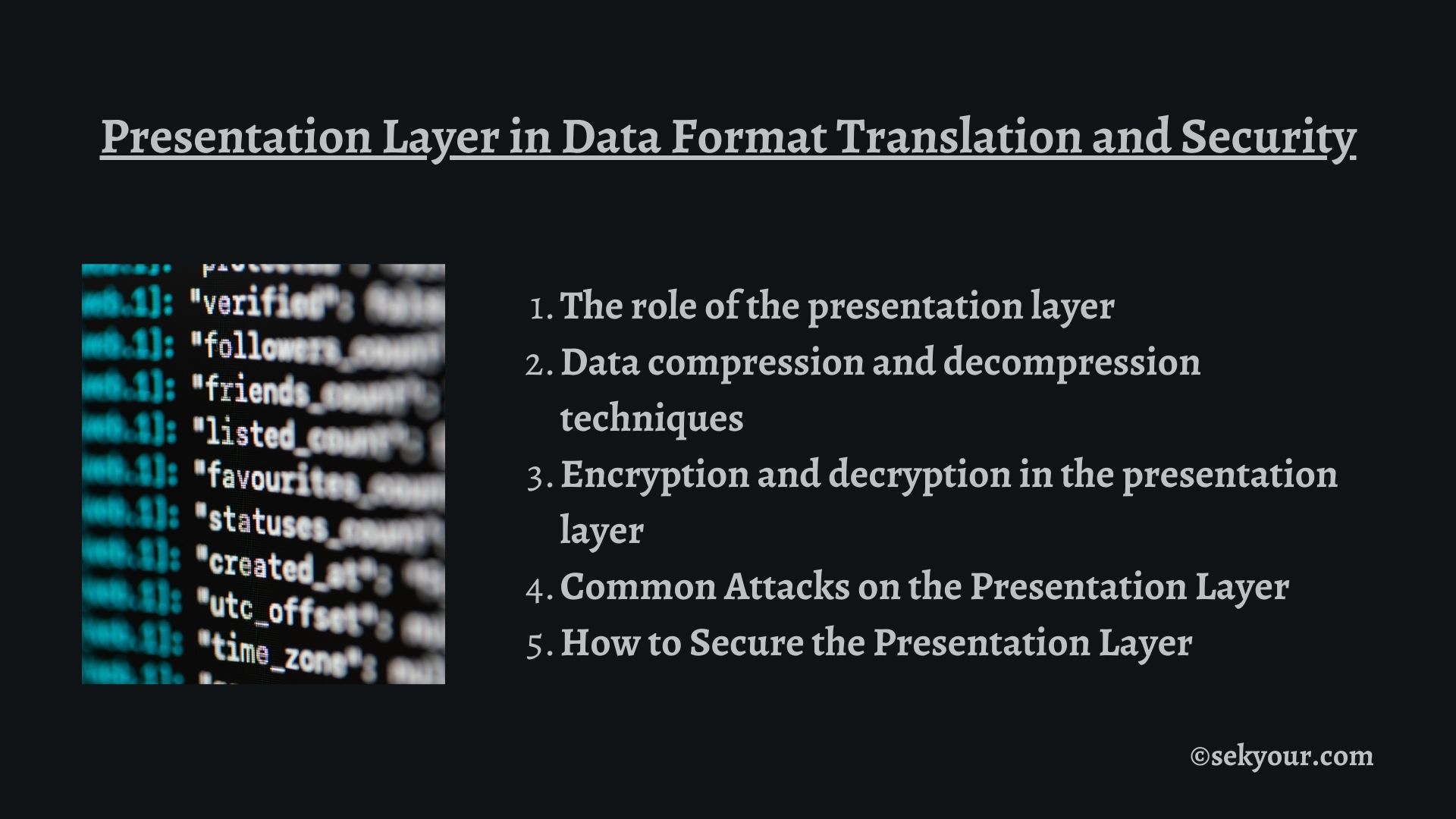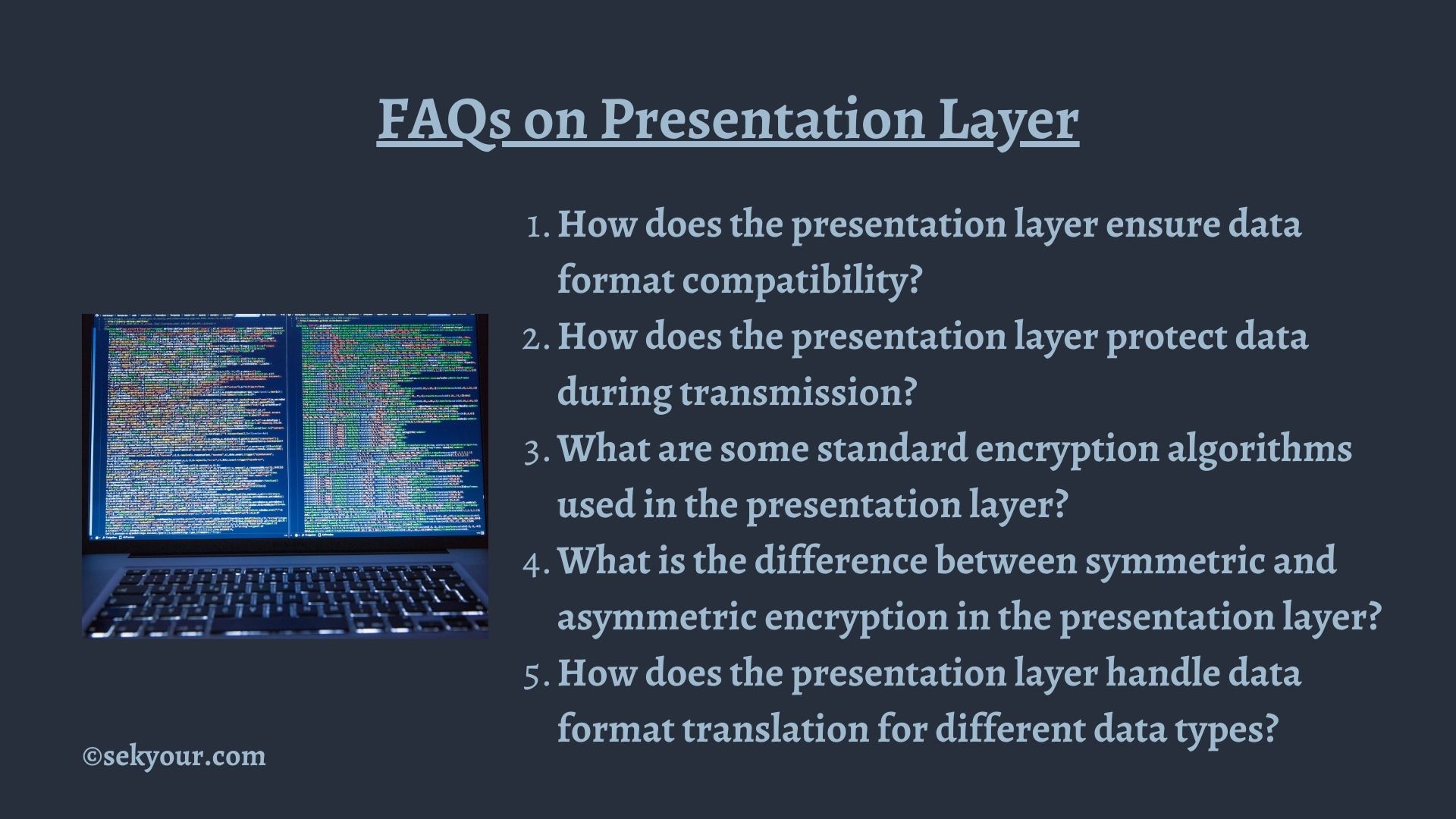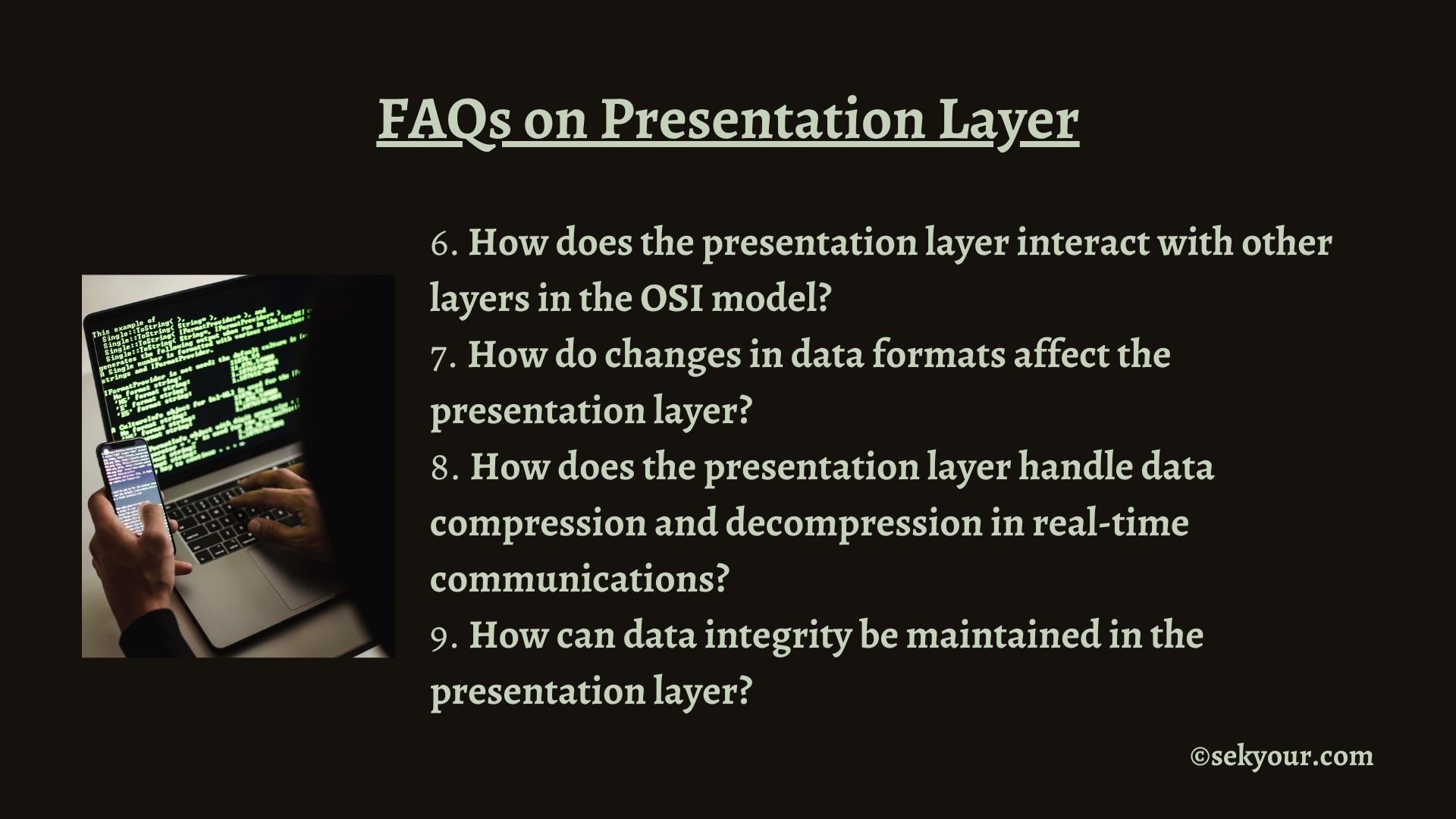1. Introduction
According to a recent study conducted by the Institute of Electrical and Electronics Engineers (IEEE), the presentation layer is responsible for ensuring that the data is in a format that is acceptable to the application layer. This includes data compression and decompression, encryption and decryption, and character set conversion. In today’s data-driven world, the ability to effectively manage and secure data is becoming increasingly important, and understanding the role of the presentation layer in this process is crucial.
This article will explore the techniques and technologies used in the presentation layer to perform data format translation, compression and decompression, and encryption and decryption. This will include a discussion of the benefits and limitations of these techniques, as well as real-life examples and case studies of their implementation. By the end of this article, readers will have a solid understanding of the role and functions of the presentation layer in the OSI model and how it contributes to secure and efficient data transmission.

2. The role of the presentation layer
The presentation layer, also known as the syntax layer, is the sixth layer in the OSI model. It ensures that the data is in a format acceptable to the application layer. This includes data format translation, compression and decompression, encryption and decryption, and character set conversion. It acts as an interface between the application layer and the rest of the layers in the OSI model.
Data Format Translation:
The presentation layer is responsible for translating data between different formats so the application layer can understand it. For example, it may convert a file from one format, such as TIFF, to another format, such as JPEG. This ensures that the data is in a form that is compatible with the application layer and can be processed accordingly.
Compression and Decompression:
Another essential function of the presentation layer is data compression and decompression. The layer compresses the data before sending it to the next layer, the network layer. This reduces the amount of data that needs to be transmitted, reducing the time required for the data to be shared. Once the data reaches the destination, the decompression process takes place, and the data is restored to its original form. There are various compression and decompression techniques like LZ77, LZ78, and Huffman coding that are used to compress and decompress data.
3. Data compression and decompression techniques
Data compression and decompression are essential functions of the presentation layer in the OSI model. Compression refers to reducing the amount of data that needs to be transmitted. At the same time, decompression restores the data to its original form once it reaches the destination. The use of compression techniques can significantly reduce the amount of time required for data to be transmitted, as well as reduce the bandwidth needed for transmission.
The presentation layer’s most commonly used compression techniques include LZ77, LZ78, and Huffman coding.
LZ77:
LZ77 is a lossless data compression algorithm that Abraham Lempel and Jacob Ziv first introduced in 1977. It replaces repeated instances of a data string concerning the original series. LZ77 is a dictionary-based algorithm that uses a sliding window to identify and replace repeated data instances. This technique is effective at compressing data that contains many repeated patterns, but it can be less effective on highly random data.
LZ78:
LZ78 is another lossless data compression algorithm that Lempel and Ziv introduced in 1978. It is similar to LZ77 but uses a different data compression approach. Instead of using a sliding window, LZ78 uses a dictionary of previously encountered data strings. This approach allows LZ78 to achieve higher compression ratios than LZ77 but also requires more memory and processing power.
Huffman coding:
Huffman coding is a lossless data compression algorithm introduced by David Huffman in 1952. Huffman coding is a variable-length coding algorithm that assigns shorter codes to more frequently occurring symbols in the data. This technique is especially effective for compressing data that contains many repeating characters, such as text or DNA sequences.
Each technique has its advantages and disadvantages; LZ77 and LZ78 are simpler than Huffman coding and can be implemented quickly. With a limited amount of memory, on the other hand, Huffman coding is more efficient in terms of compression ratio, but it is more complex and memory-intensive.
In real-life examples, all three algorithms have been used in various applications. For instance, LZ77 has been used to compress data in the telecommunications industry, and LZ78 has been used in data storage devices like hard drives and flash drives. In contrast, Huffman coding compresses text, images, audio and video files.
4. Encryption and decryption in the presentation layer
Encryption and decryption are essential security measures that are used to protect sensitive information as it is transmitted over a network. In the OSI model, encryption and decryption occur at the presentation layer. The presentation layer is responsible for ensuring that the data is in a format acceptable to the application layer, and it also ensures that the information is protected during transmission.
Encryption refers to converting plain text into an unreadable form, known as ciphertext. The ciphertext can only be read and understood by someone with the correct decryption key. Decryption, on the other hand, is the process of converting ciphertext back into plain text using the right decryption key.
The importance of encryption and decryption in the presentation layer is clear, especially with the rise of cyber threats. It ensures that only authorised parties can access and understand the sensitive information being transmitted. Without encryption and decryption, sensitive data would be vulnerable to eavesdropping and tampering.
There are two main types of encryption and decryption methods that are commonly used in the presentation layer: symmetric key encryption and asymmetric key encryption.
Symmetric key encryption:
Symmetric key encryption is a method of encryption where the same key is used for both encryption and decryption. This method is fast and efficient, but it also has some drawbacks. The main disadvantage is that the key must be securely exchanged between the sender and the receiver before any encryption can occur.
Asymmetric key encryption:
Asymmetric key encryption, also known as public key encryption, is a method of encryption where a pair of keys is used. One key is used for encryption, and the other is used for decryption. This method is more secure than symmetric key encryption because the key used for encryption can be made public, while the key used for decryption is kept private.
In real life, symmetric key encryption is used for bulk encryption, for example, in the transportation of email, instant messaging and other types of data where the speed of encryption is more important than key exchange. On the other hand, Asymmetric key encryption is often used for digital signatures, online transactions and handshaking in secure connections.
5. Common Attacks on the Presentation Layer
The Presentation Layer in the OSI model ensures data security during transmission. However, like any other layer in the OSI model, it is also vulnerable to various attacks, vulnerabilities, and threats. These can have severe consequences, such as unauthorised access or manipulation of sensitive information.
One standard attack on the presentation layer is a “format string attack”. This occurs when an attacker can insert random formatting characters into a string, which can then be used to disrupt the normal execution of a program. This can lead to various consequences, including buffer overflows, which can be used to execute arbitrary code or crash the system.
Another attack that targets the presentation layer is “malicious code injection”. This occurs when an attacker can insert malicious code into a seemingly benign file or message. This can be done by exploiting vulnerabilities in data format translation or compression/decompression mechanisms. Once the malicious code is executed, it can cause various types of damage, such as data loss, unauthorised access to sensitive information, or even complete system compromise.
In addition to these specific attacks, the presentation layer is vulnerable to more general threats, such as “man-in-the-middle” or “replay” attacks. These are attacks in which an attacker intercepts and alters communications between two parties to gain unauthorised access to sensitive information. Such attacks can occur on any OSI model layer, but they are particularly dangerous when they target the presentation layer, as the attacker can manipulate or intercept data in transit.
6. How to Secure the Presentation Layer
Securing the Presentation Layer in the OSI model is crucial for protecting sensitive information during transmission. There are various security best practices that organisations can implement to protect against attacks, vulnerabilities, and threats on this layer.
One critical best practice is to keep software and systems up-to-date with the latest security patches and updates. This ensures that known vulnerabilities are fixed, making it harder for attackers to exploit them. It’s also important to regularly monitor systems and networks for signs of suspicious activity, such as unusual traffic patterns or login attempts.
Another best practice is to use secure protocols for data transmission and storage. Examples of secure protocols used at the Presentation Layer are Transport Layer Security (TLS) and Secure Sockets Layer (SSL), which encrypt communications between parties. Additionally, the use of robust encryption and decryption mechanisms, such as symmetric and asymmetric key encryption, can help protect against man-in-the-middle and replay attacks.
Enforcing strict access controls and implementing a solid data classification system can also secure the presentation layer. This includes access controls to limit who can view, modify or delete sensitive data and a data classification system which can help determine how data is handled, processed and protected.
Implementing a robust incident response plan that includes detailed procedures for identifying, containing and reporting security incidents can also be a valuable asset in case of a security breach. It’s also important to regularly train employees on security best practices and to make them aware of the importance of security in the presentation layer.
In addition, performing regular penetration testing, Vulnerability Assessments, and security audits can also help to identify and address security vulnerabilities. This can include testing the effectiveness of encryption and decryption mechanisms, evaluating the robustness of access controls, and identifying potential vulnerabilities in data format translation and compression/decompression mechanisms.
7. Conclusion
In conclusion, the presentation layer in the OSI model is a critical component in the data transmission process. Its functions include data format translation, data compression and decompression, and encryption and decryption. These functions are vital to ensure that the data is in a format compatible with the application layer and to protect the data during transmission.
We have discussed how the presentation layer plays a vital role in the OSI model. The techniques and technologies used in the presentation layer to perform data format translation, compression and decompression, encryption and decryption. The article also includes the advantages and disadvantages of each technique, real-life examples and case studies, if applicable, that illustrate the concepts and makes them more relatable.
The topic of the presentation layer in the OSI model is essential for anyone working in the network security and communications field, as it provides an understanding of how data is protected and formatted during transmission. We hope this article has provided a comprehensive understanding of the role and functions of the presentation layer in the OSI model.
However, it’s important to note that the Presentation Layer, like any other layer in the OSI model, is also vulnerable to various attacks, vulnerabilities, and threats. Therefore, it is crucial to implement security best practices to protect against these threats, such as keeping software and systems up-to-date with the latest security patches and updates, using secure protocols, and robust encryption and decryption mechanisms. Strict access controls, incident response plans, and regular security assessments can also help secure the Presentation Layer.
8. FAQs on the Presentation Layer

- How does the presentation layer ensure data format compatibility?
The presentation layer ensures data format compatibility by providing a set of protocols and standards for data representation and encoding. These protocols, such as ASCII or Unicode, define a standard format for data so that it can be easily understood and processed by different systems. This helps to ensure that data can be exchanged between other systems without loss of meaning or integrity.
- How does the presentation layer protect data during transmission?
The presentation layer protects data during transmission by using various encryption techniques to ensure that the data is secure as it is transmitted over a network. Encryption is the process of converting plaintext data into a coded format (ciphertext) unreadable by unauthorised parties. Standard encryption methods used at the presentation layer include SSL (Secure Sockets Layer) and TLS (Transport Layer Security).
- What are some standard encryption algorithms used in the presentation layer?
Some standard encryption algorithms used in the presentation layer include:
- RSA (Rivest-Shamir-Adleman)
- AES (Advanced Encryption Standard)
- DES (Data Encryption Standard)
- 3DES (Triple Data Encryption Standard)
- What is the difference between symmetric and asymmetric encryption in the presentation layer?
Symmetric key encryption and asymmetric key encryption are both encryption methods that are used to protect data during transmission, but they use different techniques to secure the data.
Symmetric key encryption uses a single shared key for encryption and decryption, meaning that the sender and receiver both have to use the same key to encrypt and decrypt the data.
Asymmetric key encryption, also called public-key encryption, uses a pair of keys, one for encryption (the public key) and one for decryption (the private key). So the sender uses the recipient’s public key to encrypt the data, and the recipient uses their private key to decrypt the data.
- How does the presentation layer handle data format translation for different data types?
The presentation layer handles data format translation for different data types using a set of protocols and standards for data representation and encoding. These protocols, such as ASCII or Unicode, define a standard format for data so that it can be easily understood and processed by different systems. The presentation layer can also use data conversion algorithms to convert data between other formats, such as a Word document to a PDF.

- How does the presentation layer interact with other layers in the OSI model?
The presentation layer, the sixth layer in the OSI model, acts as an intermediary between the application layer (layer 7) and the session layer (layer 5). It is responsible for translating data between different formats and encoding schemes, and it is also responsible for compressing and decompressing data. The presentation layer communicates with the application layer to convert the data it receives into a format the application can understand. It also communicates with the session layer to establish, manage, and terminate sessions between networked devices.
- How do changes in data formats affect the presentation layer?
Changes in data formats can have a significant impact on the presentation layer, as the presentation layer is responsible for converting data between different formats. The presentation layer must be updated when data formats change to support the new design. If this is done, the presentation layer can convert the data, which may be unreadable or lost. Additionally, there are changes in the protocol or standard used in the presentation layer. In that case, it will affect the compatibility with other systems, so the sending and receiving ends have to use the same protocol. Otherwise, they would not be able to understand each other.
- How does the presentation layer handle data compression and decompression in real-time communications?
The presentation layer is responsible for compressing and decompressing data in real-time communications. Compression reduces data size to improve transmission efficiency, while decompression restores the data to its original format. The presentation layer uses various compression algorithms to compress data and the same algorithms to decompress the data when it is received.
In real-time communications, the presentation layer might use lossless compression algorithms to compress the data in order not to lose any information but at the same time still be able to compress the data to a smaller size.
- How can data integrity be maintained in the presentation layer?
Data integrity in the presentation layer can be maintained using encryption, secure hash algorithms, and error-detection codes.
Encryption is the process of converting plaintext data into a coded format (ciphertext) that is unreadable by unauthorised parties. This helps to protect data from unauthorised access and modification during transmission.
Secure hash algorithms are used to create a unique digital signature for each piece of data, which can be used to verify the integrity of the data upon receipt. This helps to detect any changes or modifications that may have occurred during transmission.
Error-detection codes are used to detect errors in the data during transmission and can help to correct these errors.
Additionally, the presentation layer can also use a digital signature or digital certificate to ensure the authenticity of data, which is the process of using a digital signature to ensure that the data is not tampered with during transmission.